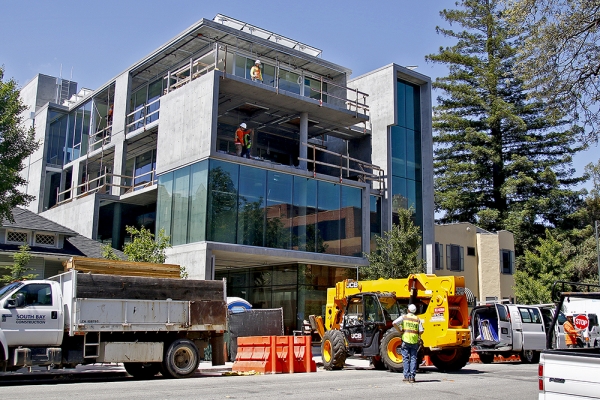• View all sections of this cover story with photos.
Some call it a blunt and unnecessary tool.
Others say it's a much-needed panacea for the city's growing pains.
The topic of whether the city should limit development to a fixed total square footage and, if so, what that cap should cover has been debated in Palo Alto for more than three decades.
The driver of the conversation is usually, well, drivers. In 1986, downtown's parking and traffic problems prompted the City Council to approve a study that ultimately established a 350,000-square-foot cap on non-residential development in downtown and to tighten up rules on building density and required parking spaces.
At the time, the council was responding to a period of rapid growth, with more than 470,000 square feet of commercial space approved between 1980 and 1984. (By contrast, the city produced only 120,000 square feet of new commercial space between 1971 and 1979.)
This dynamic, according to a 1985 report, "recreated a vitality of downtown Palo Alto which has been lost after the opening of Stanford Shopping Center, almost 30 years later." Yet the growth also created traffic jams and parking shortages, according to the study.
"Congestion Downtown continued to increase, caused by both Downtown Palo Alto traffic and by through traffic going to and from other locations, generally outside the city's boundaries," states a 1986 study that could've easily been penned in 2017. "Concerns in the community arose regarding the increased level of traffic that was being generated by the recently approved projects in Downtown Palo Alto."
In addition to creating the 350,000-square-foot cap, the council directed staff to review the limit once new development reached a threshold of 235,000 square feet — which it did in 2013. Today, there are 281,770 square feet of new development in the downtown area, along with two projects in the city's planning "pipeline" totaling 29,950 square feet. This leaves just 38,280 square feet of development allowed under the downtown cap.
The limitation — along with the policy of re-evaluating it — is enshrined in the existing Comprehensive Plan, approved in 1998. The document also includes a broader cap of 3.26 million square feet on non-residential development in nine planning areas throughout the city that were identified in a 1989 land use study.
In addition to these two long-existing caps, the City Council adopted two years ago an annual 50,000-square-foot limit on office and research-and-development projects in downtown, along El Camino Real and around California Avenue.
As part of the Comprehensive Plan revision, one of the most significant questions that the council wrestled with is what to do about these three caps. It didn't take long for members to reach a consensus on maintaining the overall cap, which today allows an additional 1.7 million square feet of development throughout the city. That cap will remain in the Comprehensive Plan.
There was more disagreement about the 50,000-square-foot office cap, with council members generally agreeing that it should be kept but disagreeing over whether it should be included in the updated Comprehensive Plan. (They ultimately agreed to leave it out but to pass an ordinance continuing the policy.)
The biggest clash came over the downtown cap. On Jan. 30, the council moved to abolish the downtown development limit entirely, with Councilman Cory Wolbach and Mayor Greg Scharff advocating that route. Both argued that, as the city's most transit-friendly area, downtown is also the part of the city most suitable for growth.
"If we're gonna have further office development or RND (research-and-development) development in Palo Alto, downtown is still one of the smartest places to put it," Wolbach said.
Scharff seconded Wolbach's motion and pointed to the low rate of solo drivers among employees of downtown's biggest companies (a recent survey by the Palo Alto Transportation Management Association indicated that only 26 percent of them drive alone to work). Scharff called the rate "amazing."
"If we're looking for the best places to do (commuter) trip reduction, it's downtown," Scharff said. "Nowhere else in the city comes close to that."
Those on the council who favor slow city growth rejected this view. Much like their 1986 counterparts, they pointed to downtown's parking and traffic problems as the main reasons why the downtown cap should remain.
Councilman Eric Filseth, who made a failed bid to restore the downtown cap, pointed to a recent citizens survey showing a growing number of citizens reporting that they don't believe the council is acting in their interests.
"Why is this happening?" Filseth asked. "Probably not because we let Facebook get away, and we haven't densified fast enough."
While he agreed that downtown is served by more public transit than other areas, he said that adding development will not reduce car commuters but merely increase them at a slower rate.
Councilman Tom DuBois joined Filseth, Karen Holman and Lydia Kou in dissent.
"I think it's pretty radical to just blow away the cap ... when we recognized all the issues we've been dealing with downtown," DuBois said.
• This article is part of a cover story on the Comprehensive Plan coming into focus. Find out what else the council is looking to change in the areas of building height limit, housing, transportation and business.



Comments
Midtown
on May 19, 2017 at 8:16 pm
on May 19, 2017 at 8:16 pm
"the low rate of solo drivers among employees of downtown's biggest companies (a recent survey by the Palo Alto Transportation Management Association indicated that only 26 percent of them drive alone to work)."
The pertinent words here are "downtown's biggest companies." How many is that actually? 5? 10? 50?
Still leaves a lot of small shops and restaurants where most employees drive.
And why should our downtown be considered a business park? It's not like the finacial district in SF; people actually live in our downtown.